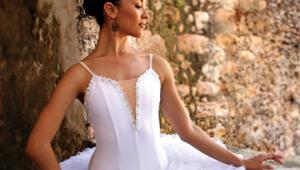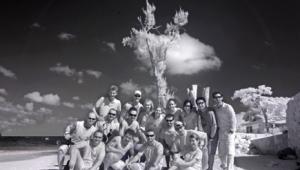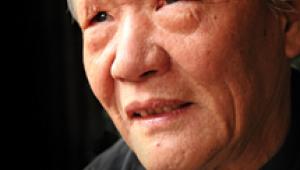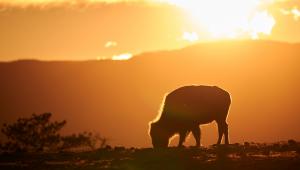Master Class
Previsualization And Post-Processing; Enhancing A “Monte Portrait” Page 2
 |
For this portrait I wanted to eliminate detail at the top of his head. I felt
that the light forehead took the viewer's eye out of the picture, so I
let the top of the picture go to completely black. I did the same at the bottom,
feeling that I didn't need to show anything there either. This is pretty
unusual for me, because I usually try to create a base to each of my portraits.
In this case, however, I liked cropping just above the tip of the chin. The
angle of the face in the composition was strong enough for me.
The crop and the blackness at the top and bottom do not break my cardinal rule:
If you like the way it looks, go with it! I liked it and I did it! Of course,
it takes a lot of experience to develop good taste. When one is just starting
out it's easy to like something without knowing if it's really good
or not. That works some of the time, but an educated opinion usually works better.
Some of the biggest changes took place at my next stage of preparation. First,
I sharpened the entire image by going to Filter/Sharpen/Unsharp Mask. I set
the Unsharp Mask at: Amount--100 percent, Radius--1.0 pixels, Threshold--0.
This showed up an amazing amount of detail throughout his face that I didn't
see at first.
 |
Then, I had the most fun of this entire process by using the Burning and Dodging
tools. Everywhere there was a highlight on his face I made it brighter using
the Dodge tool at about 10 percent opacity, selecting the highlights up top
(Range) where you have the ability to select whether you want to affect the
highlights, mid tones, or shadows. To increase some of the definition between
the highlights and shadowed parts of his face I used the Burn tool at about
a 10 percent opacity, selecting up top (Range) to work on the shadows. Undoubtedly,
I spent more time during this stage of the transformation process of this portrait
than during any of the other stages. Every time I brightened a highlight or
deepened a shadow I marveled at how effective it was. I loved the three repeating
curves in hairs of his left eyebrow.
The final stage of transformation was to work on his eyes. At almost every stage
along the way I was always working while viewing the image at 100 percent. With
the eyes I went even larger, so that I could really see what I was doing.
Again using the Burning and Dodging tools, I cleaned up some of the white areas
of his eyes, sometimes working on the bright areas and sometimes working on
the mid tones. I didn't want to brighten them so much that they would
look artificial. I'd seen that too many times in images that had been
overworked by other photographers.
 |
I even deepened some of the tones in the irises of his eyes, bringing out
the depth of them. For comparison I've put together close-ups of the before
and after of his eyes.
Finally, here is the finished portrait. Did I have this in mind when I first
created the image? Yes and no. I wanted to create something artistic, something
special. Did I know how I was going to do it? Not really. I knew that the 2/3
facial angle would show off his features the best. I always start out with a
facial analysis. I also knew that by using two main lights--one split-lighting
his face and the second one creating the modified loop-light pattern that I
use for almost all of my portraits--I could create great three-dimensional
lighting. I had just never worked the highlights and shadows as much as I did
here. I also didn't know that I was going to convert the picture into
black and white when I first began it.
Having learned negative retouching back in the "olden days" when
we worked with pencils was a great help in teaching me how to brighten the highlights,
work on specular highlights, etc. Yes, the experiences I learned as a kid all
came back to me when I created and completed this portrait.
 |
So, even though I thought I was seeing the finished picture in the viewfinder of my lens before I took the picture, I really had no idea that it would end up like this!
- Log in or register to post comments

















































